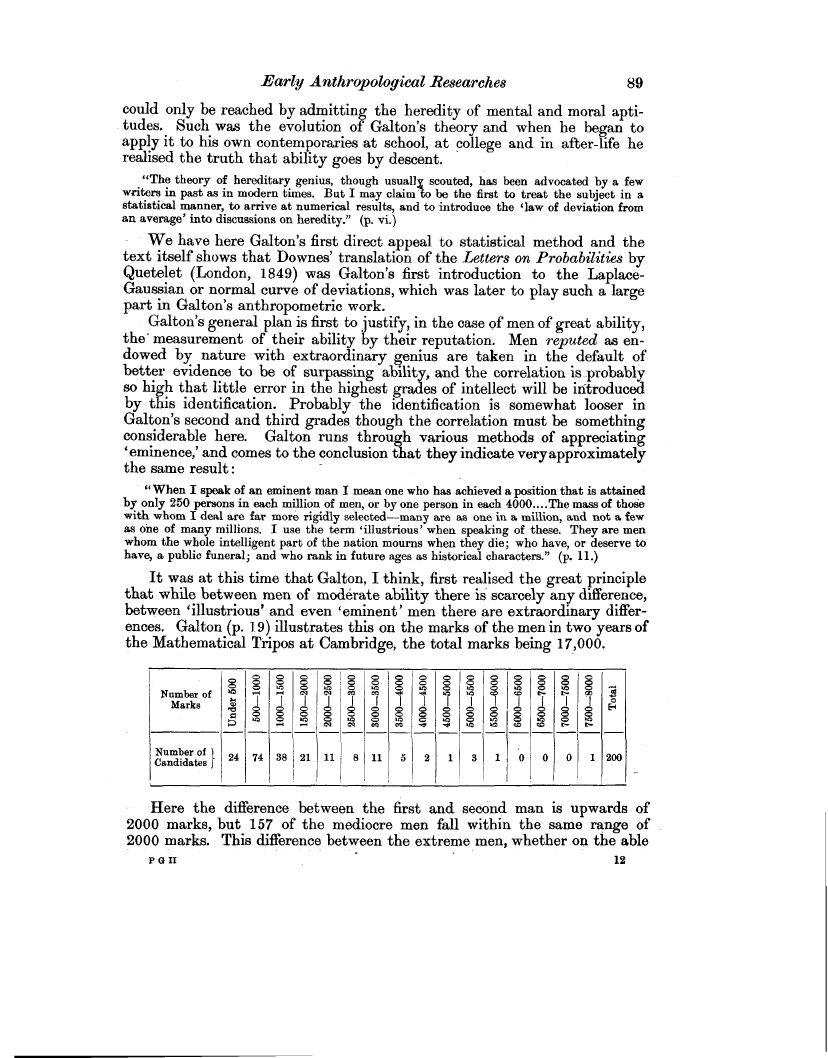Early Anthropological Researches 89
could only be reached by admitting the heredity of mental and moral aptitudes. Such was the evolution of Galton's theory and when he began to apply it to his own contemporaries at school, at college and in after-life he realised the truth that ability goes by descent.
"The theory of hereditary genius, though usual] scouted, has been advocated by a few writers in past as in modern times. But I may claim io be the first to treat the subject in a statistical manner, to arrive at numerical results, and to introduce the 'law of deviation from an average' into discussions on heredity." (p. vi.)
We have here Galton's first direct appeal to statistical method and the text itself shows that Downes' translation of the Letters on Probabilities by Quetelet (London, 1849) was Galton's first introduction to the LaplaceGaussian or normal curve of deviations, which was later to play such a large part in Galton's anthropometric work.
Galton's general plan is first to justify, in the case of men of great ability, the' measurement of their ability by their reputation. Men reputed as endowed by nature with extraordinary genius are taken in the default of better evidence to be of surpassing ability, and the correlation is probably so high that little error in the highest grades of intellect will be introduced by this identification. Probably the identification is somewhat looser in Galton's second and third grades though the correlation must be something considerable here. Galton runs through various methods of appreciating `eminence,' and comes to the conclusion that they indicate very approximately the same result
"When I speak of an eminent man I mean one who has achieved a position that is attained by only 250 persons in each million of men, or by one person in each 4000.... The mass of those with whom I deal are far more rigidly selected-many are as one in a million, and not a few
as one of many millions. I use the term 'illustrious' when speaking of these. They are men whom the whole intelligent part of the nation mourns when they die; who have, or deserve to have, a public funeral; and who rank in future ages as historical characters." (p. 11.)
It was at this time that Galton, I think, first realised the great principle that while between men of moderate ability there is scarcely any difference, between `illustrious' and even `eminent' men there are extraordinary differences. Galton (p. 1.9) illustrates this on the marks of the men in two years of the Mathematical Tripos at Cambridge, the total marks being 17,000.
| |
g |
0 |
0 |
0 |
0 |
'0 |
0 |
|
0 |
0 |
0 |
0 |
0 |
0 |
0 |
0 |
|
|
Number of |
|
|
|
|
'' |
m |
m |
|
|
'0 |
|
CO |
e'°e |
n |
r'° |
g'm |
|
|
Marks |
b |
|
|
I |
|
I |
o |
0 |
o |
I |
o |
I |
o |
I |
I |
o |
Ei |
| |
a |
+on |
oo |
g |
G |
$ |
0 |
0 |
0 |
° |
0 |
$ |
0 |
° |
0 |
a |
|
| |
|
|
.~ |
a |
Gq |
N |
CO |
m |
-44 |
4 |
I1 |
ID |
3 |
CO |
r- |
n |
|
|
Number of |
|
|
|
1 |
|
|
|
|
|
|
|
|
' |
|
|
|
|
|
Candidates j |
24 |
74 |
38 |
21 |
11 |
8 |
11 |
5 |
2 |
1 |
3 |
1 |
0 |
0 |
0 |
1 |
200 |
Here the difference between the first and second man is upwards of 2000 marks, but 157 of the mediocre men fall within the same range of 2000 marks. This difference between the extreme men, whether on the able
PGII 12

